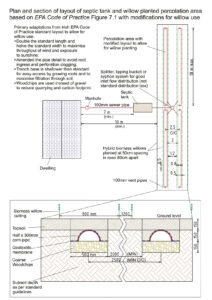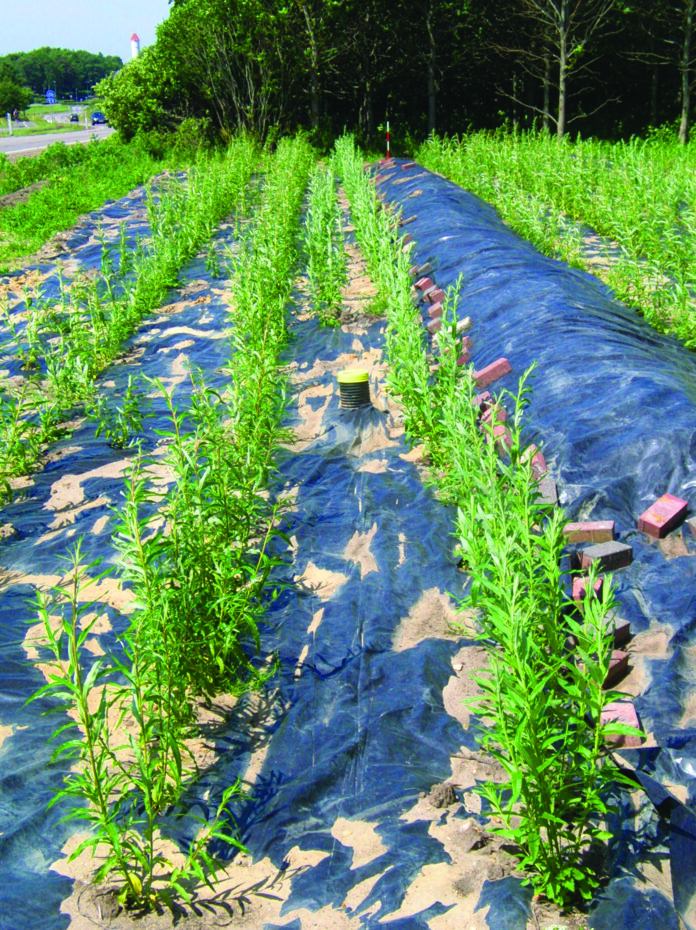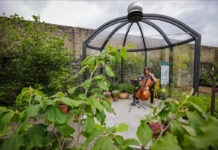Mopping up sewage pollution, sequestering carbon and promoting biodiversity – willow wastewater systems are the solution we need for one-off houses in the countryside. WORDS: Féidhlim Harty.
We seem to be on a whole suite of collision courses, including housing, climate, biodiversity and water pollution. Many young people in rural areas are looking at family land, with no prospect of being allowed to build due to poor soil percolation characteristics.
The Environmental Protection Agency’s (EPA) Code of Practice: Domestic Waste Water Treatment Systems is a government guidance document. It outlines methods and technologies for protection of groundwater and surface waters from pollution by domestic sewage from one-off houses in the countryside.
The document was updated in June 2021. However, a fundamental omission remains, namely: how do we address pollution in existing problem sites, or find practical solutions on suboptimal soils?
For ‘problem sites’, read heavy clays and peat subsoils where the infiltration rate is limited. Under the EPA’s Code, these are conditions in which septic tanks – or indeed any domestic wastewater treatment system – should not be used. In other words, sites with these conditions are deemed unsuitable for the construction of domestic dwellings.
Yet many people already live in one-off houses in the countryside with just these soil conditions. So what can be done?
Readers of this magazine will be familiar with an inevitable trend that runs through these pages: the solution is to be found in plants. Planted wastewater systems have actually been included in the EPA wastewater treatment manuals since 1999, in the form of reed bed systems and constructed wetlands. Sized and built appropriately, these can provide high quality secondary or tertiary treatment (the next grades of treatment up from primary treatment in septic tanks), with little or no electricity inputs.
 Bear in mind that the reed bed or constructed wetland is a treatment system: a fully sealed black box (although green when in full leaf), with water in and water out. Thus while these systems can provide good protection of the environment from pollution, they will not get rid of the effluent. This still requires an infiltration area for final disposal to ground.
Bear in mind that the reed bed or constructed wetland is a treatment system: a fully sealed black box (although green when in full leaf), with water in and water out. Thus while these systems can provide good protection of the environment from pollution, they will not get rid of the effluent. This still requires an infiltration area for final disposal to ground.
Discharging to surface waters (a river or stream) is listed in the EPA’s Code, but in reality local authorities will generally not grant a discharge licence for this option. When under-resourced and overstretched, it’s easier to say no to a new planning application than to play catch-up on potential pollution for ever more.
What then is the solution for sites without good infiltration characteristics – the widespread heavy clays and peat soils of the country?
WILLING WILLOWS
A Danish solution developed in the mid-1990s is to use willows. The Danes use fully-lined basins of about 1.5m deep x 6m wide x c. 45m long (depending on water use, local rainfall and evapotranspiration rates). These basins are backfilled with soil and sand in layers, so that they are slightly domed up over the existing ground level, and they are pump-fed with septic tank effluent right along the length of the willow basin.
The willow system is designed to hold rainwater and effluent over the winter months, and to provide 100 per cent evapotranspiration through the leaves of the willows during the growing season.
Quick-growing biomass willow cultivars have already been bred for agricultural applications for use as a bioenergy crop. These are hybrids of Salix viminalis and other varieties, selected for their rapid biomass production. They are excellent varieties to use in the zero-discharge willow systems, being hungry and thirsty to fuel their phenomenal growth rates.
Wexford County Council and the EPA have both carried out studies of willow systems in the Irish context. Of the 13 systems assessed by Trinity College, all overflowed at some point during the monitoring process.
The effluent was sampled and deemed to be essentially rainfall runoff. On one site there was overflow present even though the septic tank was not connected: a symptom of high rainfall and low nutrient input, which outpaced the available storage/willow uptake balance.
What is interesting to note is that the effluent from all systems tested was of a very high quality. Also, there was no discharge for much of the year – including at that crucial time of year when the volume of water in nearby field drains or streams is low.
All of this means that for existing properties with a pollution problem, willows are an excellent plant to partner with in protecting local watercourses, whether some winter overflow occurs or not.
A SUITE OF SOLUTIONS
Willow systems are now in the 2021 EPA Code – but they still require either a follow-on infiltration area or a discharge licence. Also, the large sizing required (187.5m2 per person compared with Denmark’s c. 40m2) makes willow systems uneconomical for all but the rare exception.
That said, if we look at the potentials here from the plant’s point of view, a solution starts to emerge. As a willow plant, my requirements are for moist growing conditions with abundant nutrients. I am not fussy about overly engineered surroundings, nor a plastic liner, nor even a specific size of bed in which to grow. I just want the nutrients and moisture.
In parallel with this, we have an existing pollution problem in many watercourses throughout the country, due in no small part to sewage inputs – which happen to be an excellent source of moisture and nutrients. Happily, human urine and faeces have the perfect mix of N, P and K for willow trees to thrive. Millions of years of co-evolution of plants and mammals was not wasted.
Thus, rather than asking whether willow systems are zero discharge in the Irish context or not, we could ask how to incorporate willows into every infiltration area that gets built from here on in; and into existing sites, where there are already pollution problems.
The EPA Code infiltration area sizes vary from as low as 3.75m2/person (for tertiary treated effluent on free-draining soils), upward to 54m2/person (for secondary treated effluent with a drip dispersal system on relatively heavy soils).
These measurements are still considerably lower than the Irish EPA willow system size of 187.5m2/person. Even though a larger system will mop up more nutrients, any tree will mop up nitrates and phosphates better than a lawn, the standard percolation area cover plant. Whether the willow system is large or small, any nutrients locked into willow biomass are nutrients not showing up as pollution in nearby soils and waterways.
What I would love to see for Ireland is a general reliance on plants – and willows in particular – in the normal run of events for new and existing percolation areas and sewage discharges alike.
EXPANDING WHAT’S ALREADY HERE
We’re already getting biomass electricity from Edenderry Power Station in Co Offaly, which is co-fired with willows. That would be easy to expand upon, ramping up willow biomass growing, and ensuring that all nutrient inputs for willow crops are met from sewage rather than artificial fertilisers.
The proposed sewage outfall at Portmarnock in Co Dublin would dump c. 550T of nitrogen and almost 70T of phosphorus into Dublin Bay each year – enough to fertilise 240 km2 of willow plantation as a biomass crop!
Resource-use can be minimised for willow-planted percolation areas by relying on infiltration and evapotranspiration combined, and omitting the plastic liner. On free-draining soils, willow trees capture the nitrates that otherwise migrate into the groundwater. On poorly-draining soils, the trees capture the phosphates that otherwise flow overground into rivers and streams.
A new set of guidelines on willow-planted percolation areas will be needed – specifically modifications to the piping set-up to avoid willow roots blocking the standard 4” percolation pipe runs. While pumping of effluent is the Danish standard distribution method to ensure even feeding of the full run of willows, gravity distribution systems are possible using modern splitter units or flush box applications.
We are surrounded by insurmountable opportunities. Let’s grasp them and move into a greener, plant-rich future
These measures further improve the carbon balance; not only mopping up atmospheric carbon dioxide in the growing trees, but minimising or designing out electricity inputs in the operation of the system. Standard EPA percolation area depths to bedrock or water table should still apply where possible, but the beauty of these planted systems is that where the code requirements cannot be met for some reason, the trees still help to create a safer ecological solution by compensating for the limitations of the site.
At a time when climate and biodiversity are both at crisis levels, plants are so often the answer, providing a suite of solutions: less pollution, more renewable electricity generation, improved habitat (willows are second only to oak trees in the number of species they support), and carbon sequestration.
To quote Bill Mollison, grandfather of permaculture: “We are surrounded by insurmountable opportunities.” Let’s grasp them and move into a greener, plant-rich future! ✽
 Féidhlim Harty is director of FH Wetland Systems and a writer. FHWS offers specialised courses and seminars on ecosystem repair and eco-friendly sewage treatment, and consultancy on habitat creation and regeneration. Harty is the author of Septic Tank Options and Alternatives, Permaculture Guide to Reed Beds, and other books on practical environmental solutions.
Féidhlim Harty is director of FH Wetland Systems and a writer. FHWS offers specialised courses and seminars on ecosystem repair and eco-friendly sewage treatment, and consultancy on habitat creation and regeneration. Harty is the author of Septic Tank Options and Alternatives, Permaculture Guide to Reed Beds, and other books on practical environmental solutions.
www.wetlandsystems.ie







